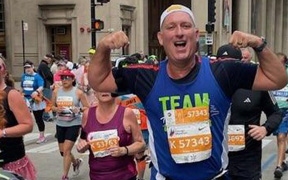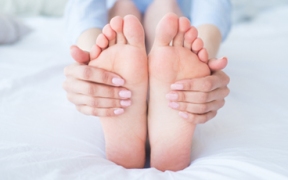Not feeling quite right after your run? Your running technique may be the cause of added foot or ankle pain after exercise. You can adjust your running form and learn how to decrease the risk of injury to improve your run.
John Linden, PT, DPT, physical therapist at Illinois Bone & Joint Institute, helps educate us on running form, decreasing the risk of injury, and the advantages of attending a running clinic.
Is there one running form that is more effective than others?
“There are a variety of ways in which people run effectively. Runners typically develop a running form that is most efficient for them from a metabolic perspective. This is great, unless they are placing undue stress on compromised or already injured structures. Changing running form is challenging, as it is an ingrained habit that is efficient for that individual. However, simple tweaks can offload tissue structures that are at risk of injury.”
What changes can I make to decrease my risk of injury?
“Generally, our goal is to have runners decrease the ground reaction forces with initial contact, so that they land with a less stressful shock, yet still have proper energy storage in the elastic tissues of the limbs to most effectively propel themselves forward during push-off. There are a number of ways to do this and can be very individualized.”
How can I decrease the risk of a foot/ankle injury while running?
“The foot is the contact point with the ground while running and is subjected to repetitive stressful loads, so it is only natural that many runners experience foot or ankle pain and injury. The most important factor is gradually exposing the feet to the increasing loads. This means [you] should avoid great increases in running distance and intensity. A general rule is increasing distance no more than 10% per week and having a recovery week every so often.
Proper shoewear is an important, yet controversial topic. The two most important factors with shoes are comfort and changing shoes regularly. Shoes that are excessively worn will not aid effectively in shock absorption. Other important factors related to the foot and ankle include strength and flexibility of the calf muscles, mobility of the big toe, and good balance.”
Cathy Irwin, PT, OCS, MHS, director of rehabilitation at Illinois Bone & Joint Institute, adds, “For running shoes, it’s important to know your running style and foot style. Knowing where you land on your foot when running is important in determining if you need a neutral shoe, more stability in the shoe or more motion control.” IBJI running clinics can help you determine which shoe works best for you.
What are the advantages of going to a running clinic?
“The running clinic can help runners in a number of different ways. The first is that runners will have the benefit of a comprehensive, individualized evaluation by medical professionals who work day after day with patients. These clinicians have a great understanding of the human body, as well as typical and atypical movement patterns. Runners who are returning from injury or have nagging pain while running will receive tips, drills, or exercises to continue making them stronger and reduce the risk of injury. Runners who are looking to improve performance can be pointed toward potential weakness in strength. Finally, the participants will actually perform the exercises under the supervision of a clinician and will be cued on proper performance, rather than just having a handout on exercises to perform.”
If you are interested in an IBJI running clinic, you can sign up for the Highland Park Running Clinic on Saturday, March 30. Be sure to watch our social media channels or events calendar to find out when the next running clinic is!
Kelsey Koziel is a Marketing Communications and Public Relations Specialist at Illinois Bone & Joint Institute.




